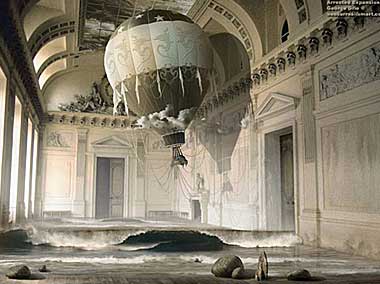Computer generated 3D still imagery
3D computer graphics (in contrast to 2D computer graphics) are graphics that use a three-dimensional representation of geometric data (often Cartesian) that is stored in the computer for the purposes of performing calculations and rendering 2D images. Such images may be stored for viewing later or displayed in real-time.
Despite these differences, 3D computer graphics rely on many of the same algorithms as 2D computer vector graphics in the wire-frame model and 2D computer raster graphics in the final rendered display. In computer graphics software, the distinction between 2D and 3D is occasionally blurred; 2D applications may use 3D techniques to achieve effects such as lighting, and 3D may use 2D rendering techniques.
3D computer graphics are often referred to as 3D models. Apart from the rendered graphic, the model is contained within the graphical data file. However, there are differences. A 3D model is the mathematical representation of any three-dimensional object. A model is not technically a graphic until it is displayed. Due to 3D printing, 3D models are not confined to virtual space. A model can be displayed visually as a two-dimensional image through a process called 3D rendering, or used in non-graphical computer simulations and calculations.
Digital installation art
Digital installation art constitutes a broad field of activity and incorporates many forms. Some resemble video installations, particularly large scale works involving projections and live video capture. By using projection techniques that enhance an audiences impression of sensory envelopment, many digital installations attempt to create immersive environments. Others go even further and attempt to facilitate a complete immersion in virtual realms. This type of installation is generally site specific, scalable, and without fixed dimensionality, meaning it can be reconfigured to accommodate different presentation spaces.[14]
Noah Wardrip-Fruin's interactive new media art piece entitled "Screen is an example of digital installation art. To view and interact with the piece, a user first enters a room, called the "Cave," which is a virtual reality display area with four walls surrounding the participant. White memory texts appear on the background of black walls. Through bodily interaction, such as using one's hand, a user can move and bounce the text around the walls. The words can be made into sentences and eventually begin to "peel" off and move more rapidly around the user, creating a heightening sense of misplacement.
"In addition to creating a new form of bodily interaction with text through its play, Screen moves the player through three reading experiences — beginning with the familiar, stable, page-like text on the walls, followed by the word-by-word reading of peeling and hitting (where attention is focused), and with more peripheral awareness of the arrangements of flocking words and the new (often neologistic) text being assembled on the walls. Screen was first shown in 2003 as part of the Boston Cyberarts Festival (in the Cave at Brown University) and documentation of it has since been featured at The Iowa Review Web, presented at SIGGRAPH 2003, included in Alt+Ctrl: a festival of independent and alternative games, published in the DVD magazines Aspect and Chaise, as well as in readings in the Hammer Museum's HyperText series, at ACM Hypertext 2004, and in other venues." [15] |

